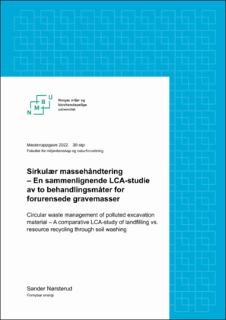| dc.description.abstract | Uttak av nytt byggeråstoff øker stadig, samtidig som store mengder gravemasser fra infrastrukturprosjekter fortsatt blir deponert. Dette er ikke i tråd med tankegangen bak en sirkulær økonomi. I denne masteroppgaven brukes livsløpsvurderingsmetodikk (LCA) til å undersøke klima- og arealpåvirkningene av to ulike måter å håndtere forurensede gravemasser: deponering (med uttak av jomfruelig byggeråstoff) og gjenvinning av massene i et jordvaskeanlegg.
Resultatene av studien indikerer at et system hvor massene blir gjenvunnet i et jordvaskeanlegg, og dermed blir returnert til økonomien, både har lavere klimapåvirkning og arealpåvirkning enn deponering. Jordvasking har en klimapåvirkning på 11,1 kg CO2 per tonn behandlet masse, mens deponering fører til en klimapåvirkning på 16,8 kg CO2 per tonn behandlet masse. Transport utgjør majoriteten av utslippet i begge alternativene, henholdsvis 70 % og 78 % av deponeringsscenarioet og jordvaskingsscenarioet. Bruk av massehub muliggjør mer effektiv transport for jordvaskingsscenarioet og reduserer utslippet vesentlig. Ettersom transport av massene utgjør en så stor del av den totale klimapåvirkningen, er det viktig å finne gode lokasjoner for vaskeanleggene med nærhet til områder med høy konsentrasjon av bygg- og anleggsaktivitet. Et annet viktig funn er at utsortering av skrapmetall fra massene på jordvaskeanlegget, som ellers ville blitt med massene på deponi, reduserer netto klimapåvirkning fra jordvaskingsscenarioet betraktelig.
Oppgaven kan være nyttig både for offentlige og private aktører med aktiviteter som involverer håndtering av gravemasser, og kan brukes som en del av et større beslutningsgrunnlag for å utforme gode massehåndteringsløsninger for samfunnet. | en_US |
| dc.description.abstract | Every year, massive amounts of virgin aggregate material is quarried from nature, while excavation material from infrastructure projects in most cases is landfilled. This is not in line with the ideas behind a circular economy. In this thesis, the global warming potential and land use impacts of two different ways of handling polluted excavation material have been assessed through life cycle assessment (LCA). Landfilling and quarrying of new material, which is viewed as the current practice in Norway, is compared to the recycling of excavation material in a soil washing plant.
The system boundaries include transportation of the excavated material to treatment (landfill or soil washing), treatment and quarrying of virgin material (in the case of landfilling). The disposal of sludge cake from the filter press at the soil washing plant was also included. However, infrastructure processes such as buildings, production of machines and landfill barrier system, were not assessed. In addition to recycling excavation material back into the economy, the soil washing plant was able to sort out other waste streams, such as steel, from the mineral waste. The soil washing system was therefore credited the avoided burden of the production of virgin material through system expansion. The functional unit was defined as the waste treatment of 1 ton polluted excavation material, including transportation and production of the same amount of virgin material that is recycled through soil washing.
Treatment was assumed to be off-site for both treatment options - a little researched approach in literature. The transportation distances to disposal and soil washing plant used in the analysis was 59.5 km and 54.1 km, respectively. Inert material was assumed to make up 96 % of the total excavated mass and was therefore disposed of in an inert material landfill, whereas the rest of the mass went to sanitary landfill. The share of clean material from the soil washing plant was assumed to be 80 %, meaning 20 % (sludge) was disposed of at a sanitary landfill on site.
The results indicate that soil washing both has lower global warming potential and less land use impacts than landfilling. Landfilling and quarrying of new material has a global warming potential of 16.8 kg CO2 per functional unit, while soil washing leads to 11.1 kg CO2 per functional unit. Transportation to treatment was found to be the main contributing factor for both treatment options, making up 70 % and 78 % of the landfilling scenario and the soil washing scenario, respectively. Minimizing the driven distance per ton of mass transported is therefore found to be of great importance. As the results indicate, this can be done by locating soil washing plants nearer “hot-spots” of infrastructure projects - usually meaning nearer larger cities. Soil washing also allows efficient transportation by supplying clean material for the return transport when waste is delivered to the plant, reducing CO2-emission by 54 % compared to the base scenario. This clean material can then be temporarily stored at a site within close proximity of infrastructure projects.
When only comparing the two treatment plants themselves, landfilling has slightly lower CO2-emission than soil washing, owing to less use of electricity and other input factors. However, when accounting for the landfill alternative’s need for quarrying of new material, the soil washing system has less global warming potential. Another main finding was that the sorting of steel at the soil washing plant leads to major reductions in the net results of the soil washing alternative, reducing the global warming potential by 19 %.
Regarding land use impacts, landfilling has higher impacts due to direct land use impacts from landfilling, owing both to use of more area per m3 of landfill capacity and to the transformation from nature to industrial area. Soil washing is assumed to be established in an old industrial area, thus no transformation from nature is assumed. Although not affecting the ranking between the two alternatives, including land use transformation (from nature to industrial area) for the soil washing scenario greatly increases its land use impacts. Nevertheless, the results of the land use analysis are highly case-specific and great caution should be shown in generalizing the results. | en_US |

